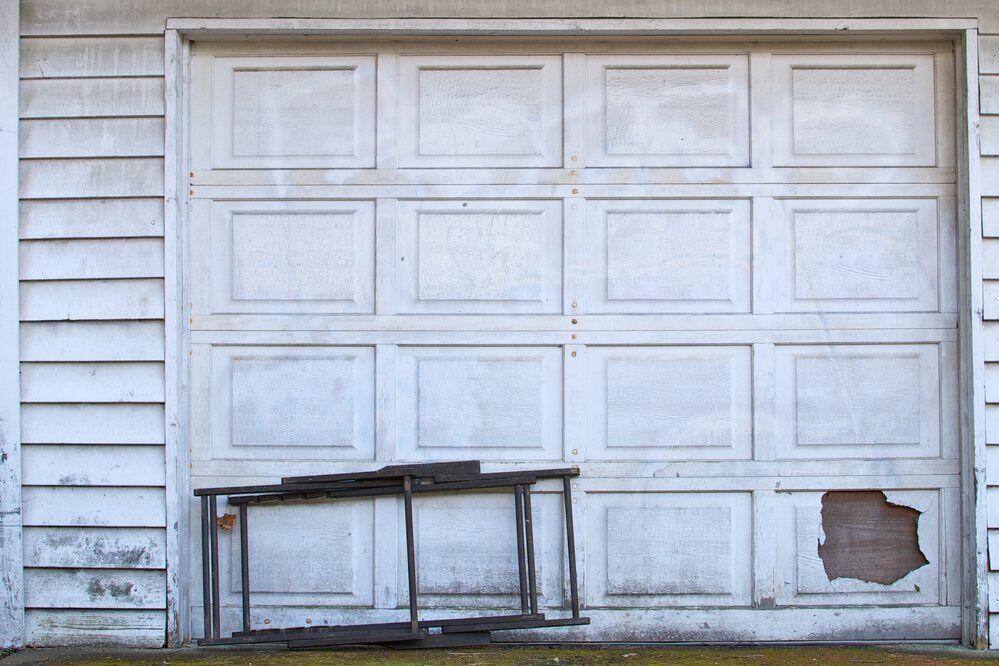Wondering if you need a new garage door, but aren’t sure? You just need to know the signs. The fact is, determining if you have an old, damaged, or broken garage door isn’t as easy as it may sound. There are many different components to a a functioning garage mechanism. Or, perhaps you’ve been thinking about repairing or replacing your garage door for a while but just aren’t sure what your best options are. Well, worry not, we are here to help. Let’s approach this as though it were a checklist.
The first and most obvious sign that you need a new garage door should be its appearance. Still, not everyone has the money to replace it based on appearance alone. Consider, however, that not only do dings, dents, and other damage detract from your home’s curb appeal, but depending on how bad the damage is, they can present a major security issue. If your garage door is not completely sound, you could risk a potential incursion into your home. Of course, this would also depend on what your garage door is made of.
What is Your Garage Door Made of?
If you have a wooden garage door and it is showing cracks, holes, or peeling paint, you might have rot. If you don’t maintain and refinish a wood door on a regular basis, it will quite literally deteriorate right before your very eyes. Not only do UV rays from the sun cause fading, but paint wears, and wood rots. Moisture easily infiltrates holes and cracks in the wood and further accelerates this process.
While steel garage doors don’t rot, they do rust. Furthermore, steel garage doors are more susceptible to dings and dents. If a steel door is too damaged, it may not even function properly and could be a safety hazard. Steel garage doors may be more durable, but just like anything mechanical, they are prone to wear, damage, breakdowns, and old age.
Speaking of old age, if your door is super old, it may not be well-insulated, or the insulation may have broken down over time. A poorly insulated garage that is attached to your house, this is especially problematic. If you want to ensure you aren’t leaching money out into the cold air and succumbing to sky-high energy bills, you need to pay attention to your door’s old age. Old wooden garage doors especially don’t last forever.
Sagging, Shaking, and Noise-Making, Oh My!
Let’s face it, skin isn’t the only thing that sags with old age. Your garage door does as well. Wood doors tend to sag over time, especially if they are not properly and regularly maintained. If your door isn’t made of wood and is sagging, you will likely need to replace it. There is little you can do in that case. In those cases, you need to have an expert garage door repair professional come out and have a look. A sagging door is definitely a security issue and should be addressed immediately.
Furthermore, if your door shakes or makes a lot of noise during normal operation, it may be on its last legs. This is also true if it is not running smoothly when opening or closing, though this may also be a sign of a failing garage door opener. There may be some broken parts that need to be fixed rather than the garage door itself. Still, while some parts are easily replaced, if sections of the door show damage, you may still need to replace the whole thing. In these situations, it is likely you will hear plenty of noise coming from the the door itself or the mechanisms that operate it.
Also consider wiring. If the you have broken, damaged, or exposed wiring, this is a major danger. You could face serious injury if exposed wiring causes a catastrophic malfunction. It is critical you contact a garage door repair professional to address the problem before the worst happens. Always remember that if you are having problems opening or closing the door, you need to have someone look at it. The door should begin opening or closing within moments of you pressing the button.
When You Should “Spring” Into Action
One of the components that fails the most are your door’s torsion springs. We cannot stress enough that you should never try to fix the springs yourself. Still, you can diagnose whether they are the problem or not. If you look at your garage door from the inside, you should see a long spring mounted along the top of the door. That is your torsion spring. This mechanism plays a critical role in the safe functioning of your garage door.
The key thing to consider is that a torsion spring’s average life span is around seven years, or 10,000 cycles. Cold weather, rust, and poor maintenance weaken springs and cause damage. This is why yearly garage door maintenance and tune-ups are critically important. So, how do you know if your torsion springs are ready to kick the can?
First, check to see if the spring is stretched out. Remember, these are called torsion springs, so if there is no torsion, that’s a problem. It will be obvious if there is no torsion when the door is closed. A gap in the spring is also a problem. There should be no visible gap where the break occurs. Is your garage door crooked or off track or is any part of it misaligned? These could be signs of a problem with your torsion spring.
The fact is, if you need a new garage door, the signs will most likely be quite obvious. Fortunately, that’s what Prestige Door is here for. If you are debating whether or not to call a garage door repair professional, then most likely you should. Never second-guess damage or disrepair on something as important as your garage door. Your bank account, but more importantly your family’s safety, depends on the safe operation of this critical component of your home. Don’t leave it to guesswork.

